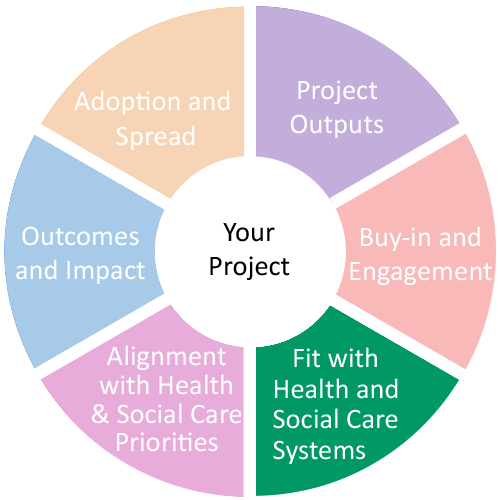Fit with Health and Social Care Systems
This domain helps you consider how implementation of your project output(s) fit with the changing needs of the health and social care systems and local, regional and national directives and policy.

What should I consider for my project?
Implementation has been shown to have a greater chance of success if it fits with the changing needs and priorities of the system into which it is being introduced. To understand how it fits, we need to find out how implementing the project output will address current gaps in health and social care delivery and provision. There are a number of ways to assess fit. For example, examining published research conducted in the field by undertaking a review of existing literature and policy documentation. If you do not have access to library resources, you may need to collaborate with academic colleagues to help with this. Another option is through informal conversations with colleagues, managers and commissioners who may be able to offer you first-hand knowledge of what is missing and how they see your plans for implementation addressing any gaps.
- What are the current gaps in health and social care delivery and provision?
- Where may you find out what these gaps are?
- Who may help you identify these gaps?
- How will implementation help address these gaps?
- What does implementation offer to relevant organisation(s) and the wider health and social care systems?
Take time to consider and investigate if implementation is locally relevant and actionable and gather any evidence to support this. For any new policy or change to practice it is likely that there will need to be guidelines, policies and documents to outline processes. Also consult with your team and local networks to gather their views and perspectives on how implementation may fit with these guidelines and processes.
- What is the evidence to support that implementation is locally relevant and actionable?
- What guidelines/policies/processes will need to be put in place to support this?
- Will a case need to be established for implementation within the organisation?
- Is there indication that this output will be commissioned?
Think about who will be involved in driving implementation. This may be more than one individual. Consider the knowledge, skills and insights needed to lead implementation. Will they need to be internal to and working within an organisation and/or external to the organisation and how will they work with others to lead implementation? Consider what incentives there may be for their involvement in implementation. For example, will this potentially benefit professional development or relational working with others.
- Do they have the knowledge, skills and insights to lead implementation?
- What support may they need?
- How will they work with others?
- What are the incentives to implement for those involved?
It is important to take into account how implementation will fit with current ways of working within organisation(s). This includes whether implementation will require changes to professional roles, responsibilities and pathways, current workloads and how it may affect how people work together within and across organisations. Implementation is more likely to be successful if it does not create additional work or duplicate existing practices. Consultation with key stakeholders will be essential to understand the potential impact of implementation on current ways of working.
- How will implementation impact on current ways of working?
- Will implementation mean people having to work in different ways?
- Will it add to existing workloads?
- Will it duplicate existing work?
Take time to consider if implementation may compete with other implementation/improvement work which is currently, or has recently, taken place within the organisation. For example, consulting with stakeholders as well as local networks may help you identify if similar initiatives have been adopted recently.
- Are there similar initiatives taking place or that have been adopted in the past 6-12 months?
- What does your project offer that differs from any similar initiatives?
It is usual that when an innovation or changes to current practice and ways of working are introduced there will be an impact on the system in which it is adopted. Think about how you might identify potential impact (positive and negative) as well as how you will assess impact. For example, you may collaborate with academic colleagues to conduct an evaluation. The evaluation will enable you to identify the extent to which implementation has brought about change for individuals, organisations and the wider health and social care system.
- How will you identify impact?
- How will you evaluate impact?
- What actions will be in place to manage any adverse effects?
Challenges may arise as a result of implementation. Such challenges might include creating additional work for those involved or not having enough time or resources to support implementation. Consulting with local stakeholders, networks and public contributors at the beginning and throughout your project, can help to identify and mitigate these. There may also be unanticipated challenges which arise during implementation. Again, consulting with local stakeholders, networks and public contributors can be helpful in considering what actions may need to be taken to address these.
- What potential challenges can you identify?
- What actions will be in place to manage these?
- Are you consulting with local stakeholders, networks and public contributors to identify these challenges as well as to mitigate them if they arise?
Supporting implementation requires resources. Resources can range from training, education to engage, practical responses, communication strategies and dissemination resources. Consider what resources will be needed to support implementation as well as who will need to be responsible for these and their capacity to support. Think about how long resources may be required and whether there are any cost associations.
- Who will be responsible for these?
- Are there cost implications?
- How long will the resources be required?
- Will these need to be updated and maintained and who will support this?
- Will there be funding/commissioning in longer term?
Think about the potential value or benefit of implementation to different stakeholders and to the wider health and social care systems. Consulting with stakeholders, networks, and public contributors at the beginning and throughout your project can help establish what value implementation may bring, as well as if this value is likely to change. Consider how the wider social, economic and political context may also shape these values.
- What is the potential value to:
- users (e.g., patients/service users/families/health care professionals/social care professionals/third sector professionals)?
- health and social care organisations?
- health and social care systems?
- Is this value likely to change?
- What are the incentives/benefits to implement for those involved? (e.g., patients, service users, family carers, health and social care professionals, third sector organisation professionals)
Case study
Parkinson’s disease Charity Community Outreach Project (PCCOP) team
“We took time to understand how the aims of our project related to local and national policy and research on improving awareness of Parkinson’s disease in the community. We also spoke to other people within our local networks about their awareness of projects relating to the topic. Because of this, early on we realised there was a project with similar aims being undertaken by another local organisation. Though this was a challenge, as we had taken time to speak to people within our local networks, we had the opportunity to consider whether our project would be able to offer something different. We realised that though the projects had similar aims they were involving different stakeholder groups. We were also able to attend learning events from the other project to understand which steps may be helpful to repeat and avoid in our own project. This was invaluable as it saved both time and resources of those involved. It also ensured that our project fitted with local and national aims and provided something of real benefit and value to our local community.”

Take away tips
- Implementation has a greater chance of success if it fits with the changing needs and priorities of the health and social care systems into which it is being introduced
- Involvement of stakeholders is key to identifying and understanding fit